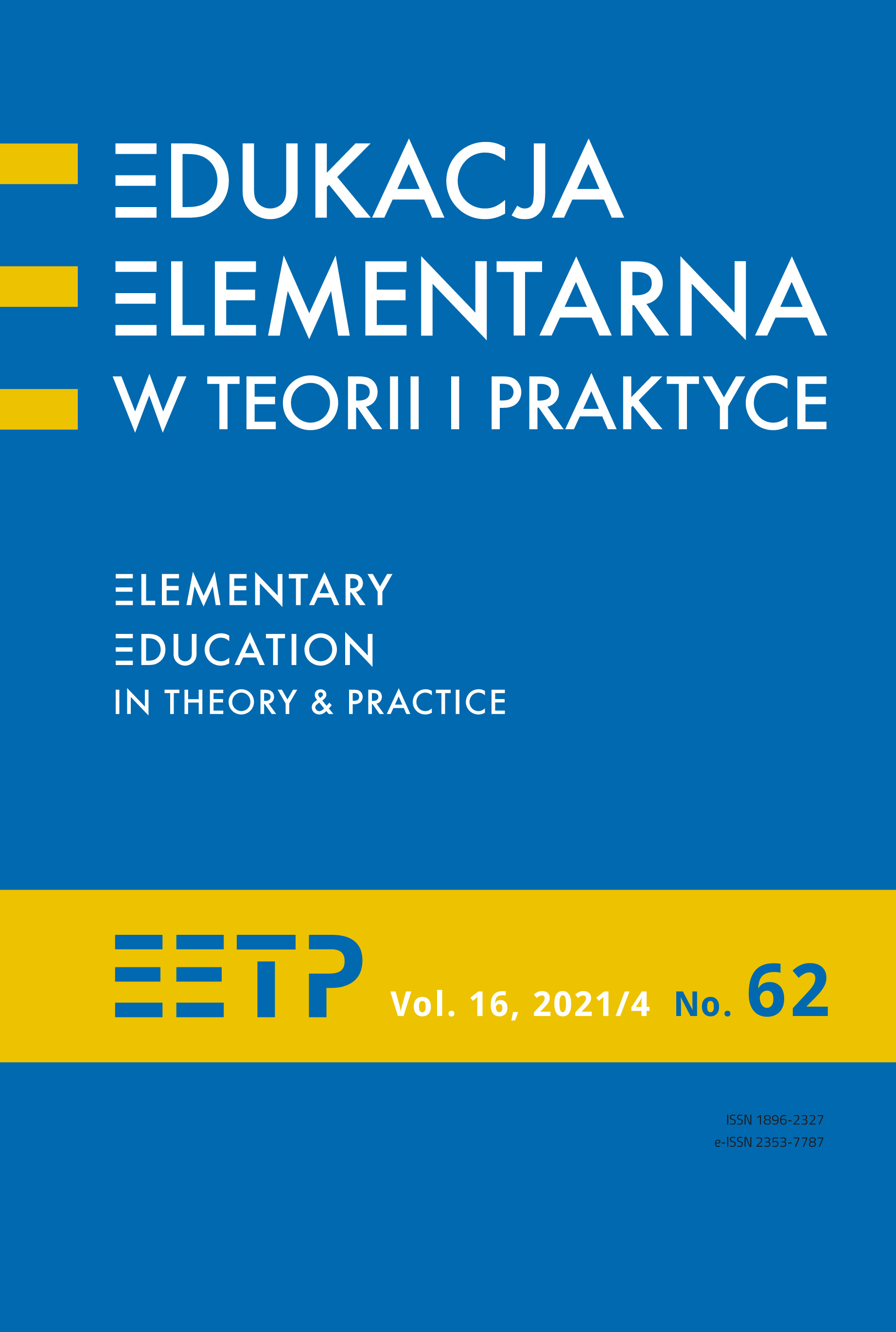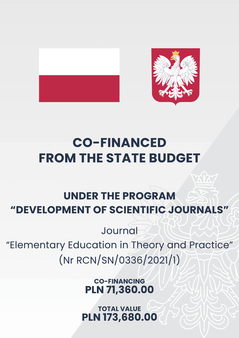The Level of Development of 6-year-old Bilingual Children in a Preschool Education Institution - a Case Study
Abstract
In recent years there has been an increasing interest in bilingual education. Poland’s membership in the European Union, access to state of the art technology as well as the opportunities for communicating with the entire world seem to naturally boost the level of requisite linguistic competence.
The article explores the problems of bilingualism in preschool children. The literature on the subject lists several varieties of bilingualism and so the paper focuses on bilingualism in successive-type children (Wróblewska-Pawlak: 90), where a second language is introduced to the child’s linguistic repertoire once communication in the first language has been established. Accordingly, the study aims to establish the levels of cognitive as well as social and emotional development in bilingual children. For this purpose, we determined the level of development in the above-mentioned areas in 6-year-old children, with special emphasis on language development. We relied on the individual case method as the principal research method, and we applied supported observation and document review as leading techniques. The study covered a group of four children: Paulina, Konrad, Kacper, and Paweł, who, since the age of 3, attended “The Oxford Kids” private English-speaking nursery located in Cieszyn, Poland. The study findings revealed that the level of development observed in children aged 6 can, depending on the area, be classified as high or average. Therefore, early contact with a foreign language has no negative impact on the child nor should it be seen as a threat to the child’s normal development. Finally, it does not constitute an obstacle to achieving other important educational aims.
References
Aleemi J. (1991). Zur sozialen und psychischen Situation von Bilingualen, Frankfurt: Peter Lang.
Baker C. (1993). Foundations of bilingual Education and Bilingualism, Clevedon (England) & Philadelphia: Multilingual Matters.
Bodanko A. (2012). Geneza, istota i zastosowanie praktyczne metody indywidualnych przypadków, „Nauczyciel i Szkoła”, t. 51, nr 1, s. 177–195.
Cummins J. (1982). Die Schwellenniveau und die Interdependenz-Hypothese: Erklärungen zum Erfolg zweisprachiger Erziehung, [w:] J. Swift (red.), Bilinguale und Multikulturelle Erziehung, Würzburg: Königshausen&Neumann, s. 34–43.
Czykwin E., Misiejuk D. (1998). Dwujęzyczność i dwukulturowość w perspektywie psychopedagogicznej, Białystok: Trans Humana.
Dakowska M., Olpińska-Szkiełko M. (red.). (2014). Edukacja dwujęzyczna w szkole i przedszkolu, Warszawa: Wydawnictwo Naukowe Instytutu Kulturologii i Lingwistyki Antropocentrycznej.
Genesee F. (1991). Second Language Learning in School Setting Lesson from Immersion, [w:] A. G. Reynolds (red.), Bilingualism, Multiculturalism, and Second Language Learning. The McGill Conference in Honour of Wallace E. Lambert, London: Lawrence Erlbaum Associates, s. 182–202.
Hambly H., Wren Y., McLeod S., Roulstone S. (2013). The influence of bilingualism on speech production: a systematic review, „International Journal of Language & Communication Disorders”, t. 48, nr 1, s. 1–24.
https://dziecisawazne.pl/fakty-mity-dotyczace-dwujezycznosci [dostęp: 18.11.2020]).
Kania M. (2013). Wpływ wybranych czynników na rozwój dwujęzyczności dzieci, „Języki Obce w Szkole”, nr 3, s. 101–105.
Komorowska H. (2005). Metodyka nauczania języków obcych, Warszawa: Fraszka Edukacyjna Sp. z o.o.
Nayeb L., Wallby T., Westerlund M., Salameh E. K., Sarkadi A. (2015). Child healthcare nurses believe that bilingual children show slower language development, simplify screening procedures and delay referrals, „Acta Paediatrica”, t. 104, nr 2, s. 198–205.
Olpińska-Szkiełko M. (2013). Wychowanie dwujęzyczne w przedszkolu, Warszawa: Wydawnictwo Naukowe Instytutu Kulturologii i Lingwistyki Antropocentrycznej.
por. http://www.p118.przedszkola.net.pl/programy/program-nauczania-jezyka-angielskiego.html [dostęp: 10.12.2019].
Por. https://www.francoisgrosjean.ch/blog_en.html [dostęp: 10.01.2020].
Sala-Suszyńska J. (2016). Dwujęzyczność jako wyzwanie edukacyjne, „Edukacja Elementarna w Teorii i Praktyce”, t. 42, nr 4, s. 131–144.
Stręk K. (2006). Jedno dziecko – dwa języki, po polsku i po niemiecku o dwujęzycznym wychowaniu, Berlin: b.m.w.
Szkolak-Stępień A. (2016). Dwujęzyczność a sprawności kognitywne dziecka, “Pedagogika Przedszkolna i Wczesnoszkolna”, t. 8, nr 2, s. 73–80.
Winsler A., Diaz R. M., Espinosa L., Rodriguez J. L. (1999). When learning a second language does not mean losing the first: bilingual language development in low-income, Spanish-speaking children attending bilingual preschool, „Child Development”, t. 70, nr 2, s. 349–362.
Wróblewska-Pawlak K. (2013). Naturalna dwujęzyczność czyli o dwujęzycznym wychowaniu dzieci, „Języki Obce w Szkole”, nr 1, s. 88–97.
Zangl R., Peltzer-Karpf A. (1998). Die Diagnose des frühen Fremdsprachenerwerbs, Berlin: Medi-mops.
Zurer-Pearson B. (2008). Jak wychować dziecko dwujęzyczne?, tłum. Z. Wodniecka, K. Chlipalski, Poznań: Media Rodzina.
Copyright (c) 2021 Elementary Education in Theory and Practice

This work is licensed under a Creative Commons Attribution-NoDerivatives 4.0 International License.
- When submitting a text, the author declares that he/she is the Author of the article (hereinafter referred to as the “Work”) and:
- he/she owns the exclusive and unlimited copyright to the Work,
- is entitled to dispose of the copyright to the Work.
Declares that it does not infringe any third party copyrights or legal rights.
Declares that there is no conflict of interest.
2. At the same time, the Author grants the Ignatianum University in Cracowa royalty-free, non-exclusive and territorially unlimited licence to use the Work in the following fields of exploitation:
- recording the Work in a hard copy, as well as on a digital or magnetic medium;
- reproduction of the Work using any technique, without limitation of the number of editions or copies;
- distribution of the Work and its copies on any medium, including marketing, sale, lending, and rental;
- introduction of the Work into a computer memory;
- disseminating the Work in information networks, including in the Internet;
- public performance, exhibition, display, reproduction, broadcasting and re-broadcasting, as well as making the Work available to the public in such a way that everyone can have access to it at a time and place of their own choosing;
- within the scope of dependent rights to the Work, including in particular the right to make necessary changes to the Work resulting from editorial and methodical development, as well as to translate the Work into foreign languages;
The licence is granted from the moment of the transfer of the Work to the Ignatianum University in Cracow. The Ignatianum University in Cracow is entitled to grant further sub-licences to the Work within the scope of the right granted. The licence is time-limited and it is granted for a period of 15 years, starting from the date of its granting.
Authors are permitted and encouraged to publish their text online (e.g. in their institution’s repository or on the institution’s website) before or during the submission process as this may lead to beneficial exchanges, as well as earlier and greater citation of the published text (See The Effect of Open Access). We recommend using any of the following portals of research associations:
- ResearchGate
- SSRN
- Academia.edu
- Selected Works
- Academic Search





